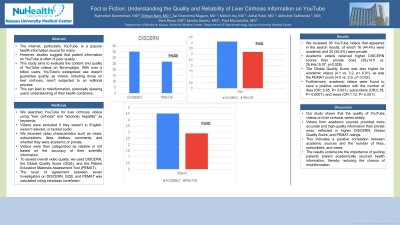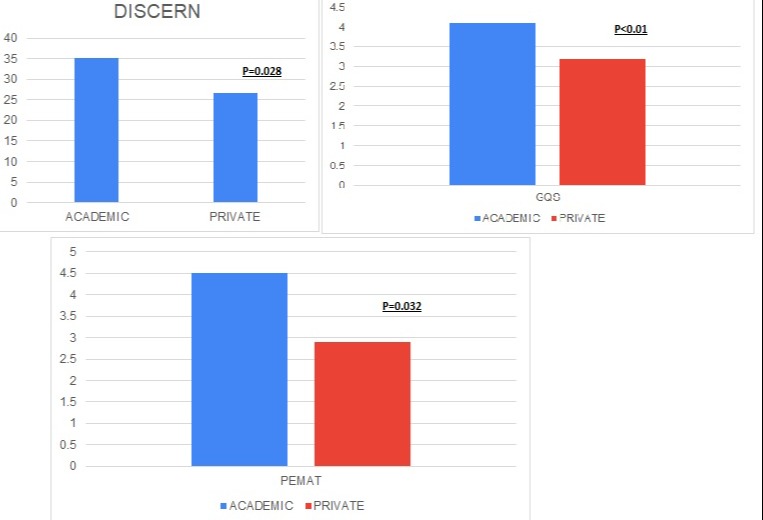Sunday Poster Session
Category: Liver
P0978 - Fact or Fiction: Understanding the Quality and Reliability of Liver Cirrhosis Information on YouTube
Sunday, October 22, 2023
3:30 PM - 7:00 PM PT
Location: Exhibit Hall

Presenting Author(s)
Rajmohan Rammohan, MD, Sai Greeshma Magam, MD, Melvin Joy, MD, Dilman Natt, MD, Tulika Saggar, MD, Achal Patel, MD, Abhishek Tadikonda, MD, Jiten Desai, MD, Sandra Gomez, MD, Paul Mustacchia, MD, MBA
Nassau University Medical Center, East Meadow, NY
Introduction: The internet, particularly YouTube, is a popular health information source for many. However, studies suggest that patient information on YouTube is often of poor quality. This study aims to evaluate the content and quality of YouTube videos on Liver cirrhosis. With over a billion users, YouTube's widespread use doesn't guarantee the quality, as videos, including those on liver cirrhosis, aren't subjected to an editorial process. This can lead to misinformation, potentially skewing users' understanding of their health conditions.
Methods: We searched YouTube for liver cirrhosis videos using "liver cirrhosis" and "alcoholic hepatitis" as keywords. Videos were excluded if they weren't in English, weren't relevant, or lacked audio. We recorded video characteristics such as views, subscriptions, likes, dislikes, comments, and whether they were academic or private. Videos were then categorized as reliable or not based on the accuracy of their scientific information. To assess overall video quality, we used DISCERN, the Global Quality Score (GQS), and the Patient Education Materials Assessment Tool (PEMAT). The level of agreement between seven investigators on DISCERN, GQS, and PEMAT was calculated using intraclass correlation.
Results: We reviewed 36 YouTube videos that appeared in the search results, of which 16 (44.4%) were academic and 20 (55.5%) were private. Academic videos received higher DISCERN scores than private ones (35±14.5 vs. 26.64±15.07, p=0.028). The Global Quality Score was also higher for academic videos (4.1 vs. 3.2, p< 0.01), as was the PEMAT score (4.5 vs. 2.9, p= 0.032). Furthermore, academic videos were found to have a positive correlation with the number of likes (OR: 0.65, P< 0.001), subscribers (OR:0.78, P< 0.0001), and views (OR:1.12, P< 0.001).
Discussion: Our study shows that the quality of YouTube videos on liver cirrhosis varies widely. Videos from academic sources provided more accurate and high-quality information than private ones, reflected in higher DISCERN, Global Quality Score, and PEMAT ratings. This indicates a positive correlation between academic sources and the number of likes, subscribers, and views. The results underscore the importance of guiding patients toward academically sourced health information, thereby reducing the chance of misinformation.

Disclosures:
Rajmohan Rammohan, MD, Sai Greeshma Magam, MD, Melvin Joy, MD, Dilman Natt, MD, Tulika Saggar, MD, Achal Patel, MD, Abhishek Tadikonda, MD, Jiten Desai, MD, Sandra Gomez, MD, Paul Mustacchia, MD, MBA. P0978 - Fact or Fiction: Understanding the Quality and Reliability of Liver Cirrhosis Information on YouTube, ACG 2023 Annual Scientific Meeting Abstracts. Vancouver, BC, Canada: American College of Gastroenterology.
Nassau University Medical Center, East Meadow, NY
Introduction: The internet, particularly YouTube, is a popular health information source for many. However, studies suggest that patient information on YouTube is often of poor quality. This study aims to evaluate the content and quality of YouTube videos on Liver cirrhosis. With over a billion users, YouTube's widespread use doesn't guarantee the quality, as videos, including those on liver cirrhosis, aren't subjected to an editorial process. This can lead to misinformation, potentially skewing users' understanding of their health conditions.
Methods: We searched YouTube for liver cirrhosis videos using "liver cirrhosis" and "alcoholic hepatitis" as keywords. Videos were excluded if they weren't in English, weren't relevant, or lacked audio. We recorded video characteristics such as views, subscriptions, likes, dislikes, comments, and whether they were academic or private. Videos were then categorized as reliable or not based on the accuracy of their scientific information. To assess overall video quality, we used DISCERN, the Global Quality Score (GQS), and the Patient Education Materials Assessment Tool (PEMAT). The level of agreement between seven investigators on DISCERN, GQS, and PEMAT was calculated using intraclass correlation.
Results: We reviewed 36 YouTube videos that appeared in the search results, of which 16 (44.4%) were academic and 20 (55.5%) were private. Academic videos received higher DISCERN scores than private ones (35±14.5 vs. 26.64±15.07, p=0.028). The Global Quality Score was also higher for academic videos (4.1 vs. 3.2, p< 0.01), as was the PEMAT score (4.5 vs. 2.9, p= 0.032). Furthermore, academic videos were found to have a positive correlation with the number of likes (OR: 0.65, P< 0.001), subscribers (OR:0.78, P< 0.0001), and views (OR:1.12, P< 0.001).
Discussion: Our study shows that the quality of YouTube videos on liver cirrhosis varies widely. Videos from academic sources provided more accurate and high-quality information than private ones, reflected in higher DISCERN, Global Quality Score, and PEMAT ratings. This indicates a positive correlation between academic sources and the number of likes, subscribers, and views. The results underscore the importance of guiding patients toward academically sourced health information, thereby reducing the chance of misinformation.

Figure: Academic vs Private study result
Disclosures:
Rajmohan Rammohan indicated no relevant financial relationships.
Sai Greeshma Magam indicated no relevant financial relationships.
Melvin Joy indicated no relevant financial relationships.
Dilman Natt indicated no relevant financial relationships.
Tulika Saggar indicated no relevant financial relationships.
Achal Patel indicated no relevant financial relationships.
Abhishek Tadikonda indicated no relevant financial relationships.
Jiten Desai indicated no relevant financial relationships.
Sandra Gomez indicated no relevant financial relationships.
Paul Mustacchia indicated no relevant financial relationships.
Rajmohan Rammohan, MD, Sai Greeshma Magam, MD, Melvin Joy, MD, Dilman Natt, MD, Tulika Saggar, MD, Achal Patel, MD, Abhishek Tadikonda, MD, Jiten Desai, MD, Sandra Gomez, MD, Paul Mustacchia, MD, MBA. P0978 - Fact or Fiction: Understanding the Quality and Reliability of Liver Cirrhosis Information on YouTube, ACG 2023 Annual Scientific Meeting Abstracts. Vancouver, BC, Canada: American College of Gastroenterology.

